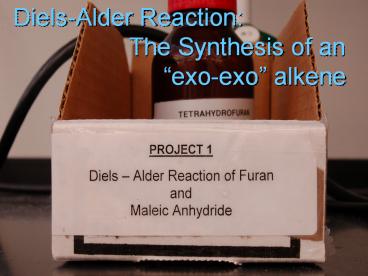Diels-Alder Reaction: The Synthesis of an exo-exo alkene - PowerPoint PPT Presentation
1 / 28
Title:
Diels-Alder Reaction: The Synthesis of an exo-exo alkene
Description:
Diels-Alder Reaction: The Synthesis of an exo-exo alkene History Of the Diels-Alder Reaction Was first discovered in 1928 by two German chemists, Otto Diels and ... – PowerPoint PPT presentation
Number of Views:538
Avg rating:3.0/5.0
Title: Diels-Alder Reaction: The Synthesis of an exo-exo alkene
1
Diels-Alder Reaction The
Synthesis of an exo-exo
alkene
2
Group 1
Ian
Nick
Lauren
Jamie
3
History Of the Diels-Alder Reaction
- Was first discovered in 1928 by two German
chemists, Otto Diels and Kurt Alder - Their find was important because its reactions
chemistry advanced the understanding of organic
reactions - Later, this find won them the Nobel Prize.
4
General Information
- Useful in organic synthesis because of the two
carbon-carbon bonds it forms in one step - When the diene and dienophile are cyclic, it is
possible to form two products with different
geometries, called exo- and endo- adducts - Most commonly, this reaction takes place in a
closed container at an elevated pressure and
temperature because dienes and dienophiles are
usually gases.
5
General Information Continued
- The dienophile gets its name because of its
ability to react with the diene
General Information Esterification
- It gets its name from an ester as the product
- from the reaction
6
Real World Uses for the Diels-Alder and
Esterification Reactions
- The Diels-Alder reaction helps to create more
useful products and solvents - An esterification reaction helps to make
biodiesel
7
Materials
- Maleic Anhydride
Hazards Harmful if swallowed, inhaled or
absorbed through the skin. Corrosive- causes
burns. Irritant. Uses- Motor oil additives, hair
spray, pharmaceuticals, and artificial sweeteners
Molecular Formula C4H2O3 Molar Mass 98.058
g/mol Melting Point 52.8-60C (226K) Boiling
Point 200C (475K) Density 1.314g/cm 3
8
Materials Continued
Hazards Extremely flammable liquid and vapor.
Vapor may cause flash fire. May form explosive
peroxides. Harmful if swallowed or inhaled.
Causes irritation to skin, eyes, and respiratory
tract. Affects central nervous system. Uses-
Degreaser
- Tetrahydrofuran
Molecular Formula C4H8O Molar Mass
72.11g/mol Melting Point -108.4C
(164.75K) Boiling Point 66C (339.15K) Density
0.886 g/cm3 _at_ 20C
9
Materials Continued
- Furan
Molecular Formula C4H4O Molar Mass 68.07
g/mol Density 0.936 g/mL Melting Point
-85.6C Boiling Point 31.4C
Hazards Extremely flammable. Vapor and air
mixtures are explosive. Cough. Sore Throat.
Redness to the skin. Furan is used in making
adhesives. Ex- Flooring adhesives
10
Materials Continued
- Methanol
Hazards Vapor harmful. May be fatal or cause
blindness if swallowed. Harmful if inhaled or
absorbed through skin. Cannot me made
nonpoisonous. Flammable liquid and vapor. Causes
irritation to skin, eyes, and respiratory tract.
Affects the central nervous system and
liver. Uses- Fuel and the making of other
chemicals.
Molar Mass 32.04 g/mol Density 0.791
g/cm3 Melting Point -98C (176K) Boiling Point
64.6C (337.8K)
11
Materials Continued
- Hydrochloric Acid
Hazards Corrosive. Liquid and mist cause severe
burns to all body tissue. May be fatal if
swallowed or inhaled. HCL has many uses such as
in the process of making fertilizers and dyes,
used in pickling, cleaning of metal products, and
is used in the rubber industry.
Molar Mass 36.46 g/mol (HCl) Density 0.909
g/cm3, 37 solution Melting Point
-114.24C Boiling Point -85.06C
12
Overall Reactions
Day 2
Day 1
13
Mechanisms
14
DAY 1 OBSERVATIONS
- Maleic Anhydride (left) was a white crystalline
solid packed into large pieces - Solid was broken up into a fine powder.
- Exactly 5 grams was added to the 25-mL round
bottom flask (w/ stir bar).
Image courtesy of global-b2b-network.com
15
DAY 1 OBSERVATIONS
- Tetrahydrofuran (THF) was a clear liquid.
- 15-mL THF added to Maleic Anhydride
- Result cloudy liquid
- Solution became clear with agitation.
Image courtesy of piercenet.com
16
DAY 1 OBSERVATIONS
- Furan was a transparent liquid with a slight
yellow tint. - 3.3-mL Furan added to solution.
- Result solution became slightly yellow.
Image courtesy of lgl.bayern.de
17
DAY 1 OBSERVATIONS
- Flask was sealed with a septum.
- Copper wire was attached to septum to add
security. - Flask was allowed to sit undisturbed from 7/18 to
7/23.
18
DAY 2 OBSERVATIONS
- Large semi-transparent white crystals were
recovered after washing and filtration w/ THF. - 5.008 g recovered (M.P. 108.1-108.6oC)
- Lit. values 4.7 g (M.P. 116-117oC)
19
DAY 2 OBSERVATIONS
- Product was mixed in 10-mL methanol (clear
liquid). - Product did not dissolve completely.
- 0.5-mL concentrated HCl was added causing no
change.
20
DAY 2 OBSERVATIONS
- Solution was refluxed for 2 hours using a water
condenser. - As the solid dissolved, heat had to be increased
to maintain reflux. - During course of reflux, solid completely
dissolved.
21
DAY 2 OBSERVATIONS
- Following reflux, the solution was cooled to room
temperature. - No solid was obtained following filtration and
immersion in an ice bath. - Solution was allowed to sit for an additional 48
hours.
22
DAY 3 OBSERVATIONS
- After 48 hours, still no product formation.
- Solution was placed in the roto-vac and still no
product was formed. - Esterfication reaction failed.
23
DISCUSSION OF RXN 1
- First reaction was a Diels-Alder reaction of a
diene (Furan) and a dienophile (Maleic
Anhydride). - Crystal formation indicated a successful
reaction. - Yield higher than literature value probably due
to slight presence of impurities.
24
DISCUSSION OF RXN 2
- Second reaction was a Fischer Esterfication
reaction of the product from RXN 1 and methanol
using concentrated HCl as a catalyst. - No product formation indicated failure of
reaction.
25
RXN 2 Failure
- The failure of RXN 2 was most likely due to an
under-concentration of HCl. - An under-concentration of HCl would have only
partially catalyzed the reaction.
26
PARTIAL CATALIZATION
27
IDEAL MECHANISM
28
Questions?































